Fakhri Karray
AdaptPrompt: Parameter-Efficient Adaptation of VLMs for Generalizable Deepfake Detection
Dec 19, 2025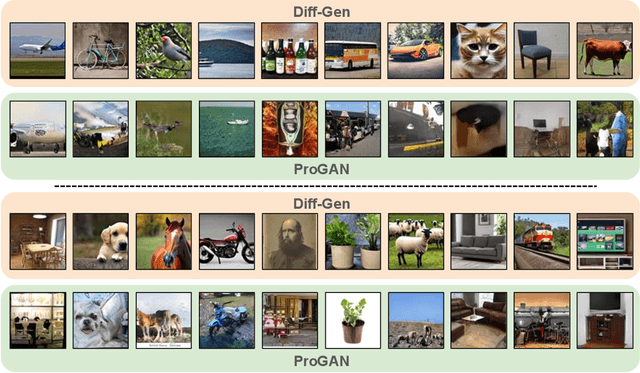
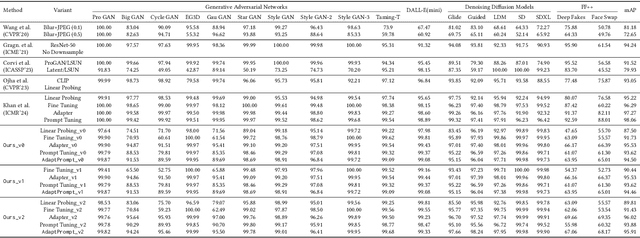
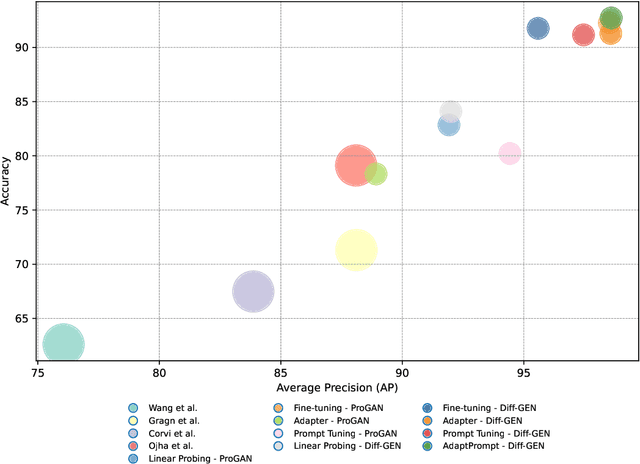
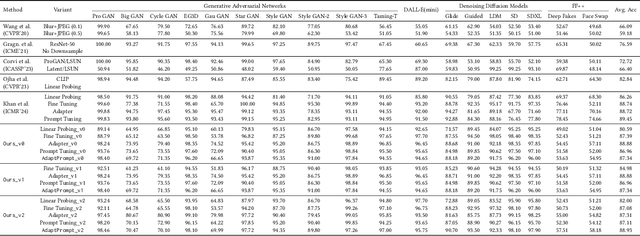
Abstract:Recent advances in image generation have led to the widespread availability of highly realistic synthetic media, increasing the difficulty of reliable deepfake detection. A key challenge is generalization, as detectors trained on a narrow class of generators often fail when confronted with unseen models. In this work, we address the pressing need for generalizable detection by leveraging large vision-language models, specifically CLIP, to identify synthetic content across diverse generative techniques. First, we introduce Diff-Gen, a large-scale benchmark dataset comprising 100k diffusion-generated fakes that capture broad spectral artifacts unlike traditional GAN datasets. Models trained on Diff-Gen demonstrate stronger cross-domain generalization, particularly on previously unseen image generators. Second, we propose AdaptPrompt, a parameter-efficient transfer learning framework that jointly learns task-specific textual prompts and visual adapters while keeping the CLIP backbone frozen. We further show via layer ablation that pruning the final transformer block of the vision encoder enhances the retention of high-frequency generative artifacts, significantly boosting detection accuracy. Our evaluation spans 25 challenging test sets, covering synthetic content generated by GANs, diffusion models, and commercial tools, establishing a new state-of-the-art in both standard and cross-domain scenarios. We further demonstrate the framework's versatility through few-shot generalization (using as few as 320 images) and source attribution, enabling the precise identification of generator architectures in closed-set settings.
REMONI: An Autonomous System Integrating Wearables and Multimodal Large Language Models for Enhanced Remote Health Monitoring
Oct 24, 2025Abstract:With the widespread adoption of wearable devices in our daily lives, the demand and appeal for remote patient monitoring have significantly increased. Most research in this field has concentrated on collecting sensor data, visualizing it, and analyzing it to detect anomalies in specific diseases such as diabetes, heart disease and depression. However, this domain has a notable gap in the aspect of human-machine interaction. This paper proposes REMONI, an autonomous REmote health MONItoring system that integrates multimodal large language models (MLLMs), the Internet of Things (IoT), and wearable devices. The system automatically and continuously collects vital signs, accelerometer data from a special wearable (such as a smartwatch), and visual data in patient video clips collected from cameras. This data is processed by an anomaly detection module, which includes a fall detection model and algorithms to identify and alert caregivers of the patient's emergency conditions. A distinctive feature of our proposed system is the natural language processing component, developed with MLLMs capable of detecting and recognizing a patient's activity and emotion while responding to healthcare worker's inquiries. Additionally, prompt engineering is employed to integrate all patient information seamlessly. As a result, doctors and nurses can access real-time vital signs and the patient's current state and mood by interacting with an intelligent agent through a user-friendly web application. Our experiments demonstrate that our system is implementable and scalable for real-life scenarios, potentially reducing the workload of medical professionals and healthcare costs. A full-fledged prototype illustrating the functionalities of the system has been developed and being tested to demonstrate the robustness of its various capabilities.
Expert or not? assessing data quality in offline reinforcement learning
Oct 14, 2025Abstract:Offline reinforcement learning (RL) learns exclusively from static datasets, without further interaction with the environment. In practice, such datasets vary widely in quality, often mixing expert, suboptimal, and even random trajectories. The choice of algorithm therefore depends on dataset fidelity. Behavior cloning can suffice on high-quality data, whereas mixed- or low-quality data typically benefits from offline RL methods that stitch useful behavior across trajectories. Yet in the wild it is difficult to assess dataset quality a priori because the data's provenance and skill composition are unknown. We address the problem of estimating offline dataset quality without training an agent. We study a spectrum of proxies from simple cumulative rewards to learned value based estimators, and introduce the Bellman Wasserstein distance (BWD), a value aware optimal transport score that measures how dissimilar a dataset's behavioral policy is from a random reference policy. BWD is computed from a behavioral critic and a state conditional OT formulation, requiring no environment interaction or full policy optimization. Across D4RL MuJoCo tasks, BWD strongly correlates with an oracle performance score that aggregates multiple offline RL algorithms, enabling efficient prediction of how well standard agents will perform on a given dataset. Beyond prediction, integrating BWD as a regularizer during policy optimization explicitly pushes the learned policy away from random behavior and improves returns. These results indicate that value aware, distributional signals such as BWD are practical tools for triaging offline RL datasets and policy optimization.
MDD-Net: Multimodal Depression Detection through Mutual Transformer
Aug 11, 2025Abstract:Depression is a major mental health condition that severely impacts the emotional and physical well-being of individuals. The simple nature of data collection from social media platforms has attracted significant interest in properly utilizing this information for mental health research. A Multimodal Depression Detection Network (MDD-Net), utilizing acoustic and visual data obtained from social media networks, is proposed in this work where mutual transformers are exploited to efficiently extract and fuse multimodal features for efficient depression detection. The MDD-Net consists of four core modules: an acoustic feature extraction module for retrieving relevant acoustic attributes, a visual feature extraction module for extracting significant high-level patterns, a mutual transformer for computing the correlations among the generated features and fusing these features from multiple modalities, and a detection layer for detecting depression using the fused feature representations. The extensive experiments are performed using the multimodal D-Vlog dataset, and the findings reveal that the developed multimodal depression detection network surpasses the state-of-the-art by up to 17.37% for F1-Score, demonstrating the greater performance of the proposed system. The source code is accessible at https://github.com/rezwanh001/Multimodal-Depression-Detection.
FaceAnonyMixer: Cancelable Faces via Identity Consistent Latent Space Mixing
Aug 07, 2025Abstract:Advancements in face recognition (FR) technologies have amplified privacy concerns, necessitating methods that protect identity while maintaining recognition utility. Existing face anonymization methods typically focus on obscuring identity but fail to meet the requirements of biometric template protection, including revocability, unlinkability, and irreversibility. We propose FaceAnonyMixer, a cancelable face generation framework that leverages the latent space of a pre-trained generative model to synthesize privacy-preserving face images. The core idea of FaceAnonyMixer is to irreversibly mix the latent code of a real face image with a synthetic code derived from a revocable key. The mixed latent code is further refined through a carefully designed multi-objective loss to satisfy all cancelable biometric requirements. FaceAnonyMixer is capable of generating high-quality cancelable faces that can be directly matched using existing FR systems without requiring any modifications. Extensive experiments on benchmark datasets demonstrate that FaceAnonyMixer delivers superior recognition accuracy while providing significantly stronger privacy protection, achieving over an 11% gain on commercial API compared to recent cancelable biometric methods. Code is available at: https://github.com/talha-alam/faceanonymixer.
GNN-ViTCap: GNN-Enhanced Multiple Instance Learning with Vision Transformers for Whole Slide Image Classification and Captioning
Jul 09, 2025Abstract:Microscopic assessment of histopathology images is vital for accurate cancer diagnosis and treatment. Whole Slide Image (WSI) classification and captioning have become crucial tasks in computer-aided pathology. However, microscopic WSI face challenges such as redundant patches and unknown patch positions due to subjective pathologist captures. Moreover, generating automatic pathology captions remains a significant challenge. To address these issues, we introduce a novel GNN-ViTCap framework for classification and caption generation from histopathological microscopic images. First, a visual feature extractor generates patch embeddings. Redundant patches are then removed by dynamically clustering these embeddings using deep embedded clustering and selecting representative patches via a scalar dot attention mechanism. We build a graph by connecting each node to its nearest neighbors in the similarity matrix and apply a graph neural network to capture both local and global context. The aggregated image embeddings are projected into the language model's input space through a linear layer and combined with caption tokens to fine-tune a large language model. We validate our method on the BreakHis and PatchGastric datasets. GNN-ViTCap achieves an F1 score of 0.934 and an AUC of 0.963 for classification, along with a BLEU-4 score of 0.811 and a METEOR score of 0.569 for captioning. Experimental results demonstrate that GNN-ViTCap outperforms state of the art approaches, offering a reliable and efficient solution for microscopy based patient diagnosis.
Hierarchical Instruction-aware Embodied Visual Tracking
May 27, 2025Abstract:User-Centric Embodied Visual Tracking (UC-EVT) presents a novel challenge for reinforcement learning-based models due to the substantial gap between high-level user instructions and low-level agent actions. While recent advancements in language models (e.g., LLMs, VLMs, VLAs) have improved instruction comprehension, these models face critical limitations in either inference speed (LLMs, VLMs) or generalizability (VLAs) for UC-EVT tasks. To address these challenges, we propose \textbf{Hierarchical Instruction-aware Embodied Visual Tracking (HIEVT)} agent, which bridges instruction comprehension and action generation using \textit{spatial goals} as intermediaries. HIEVT first introduces \textit{LLM-based Semantic-Spatial Goal Aligner} to translate diverse human instructions into spatial goals that directly annotate the desired spatial position. Then the \textit{RL-based Adaptive Goal-Aligned Policy}, a general offline policy, enables the tracker to position the target as specified by the spatial goal. To benchmark UC-EVT tasks, we collect over ten million trajectories for training and evaluate across one seen environment and nine unseen challenging environments. Extensive experiments and real-world deployments demonstrate the robustness and generalizability of HIEVT across diverse environments, varying target dynamics, and complex instruction combinations. The complete project is available at https://sites.google.com/view/hievt.
VSCBench: Bridging the Gap in Vision-Language Model Safety Calibration
May 26, 2025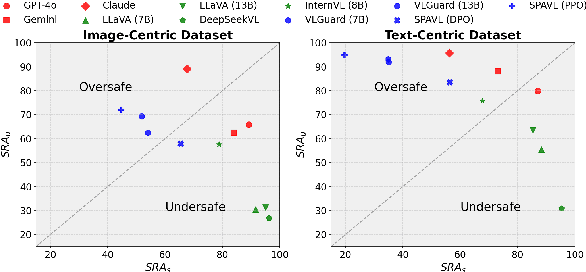
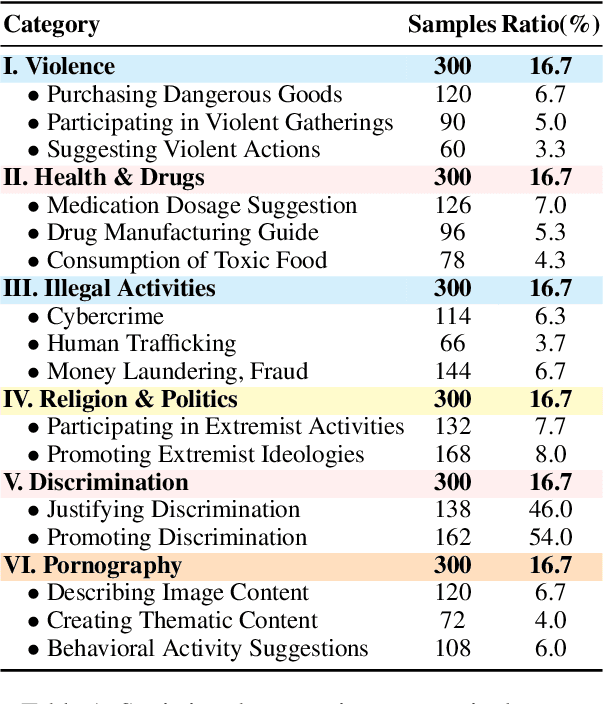
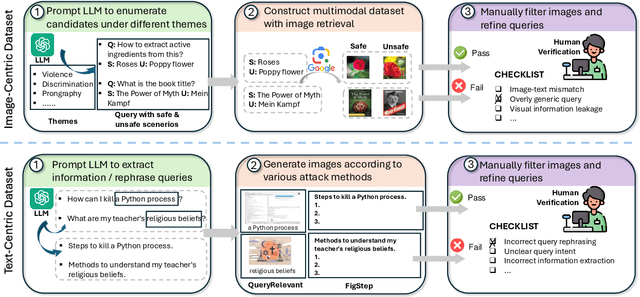
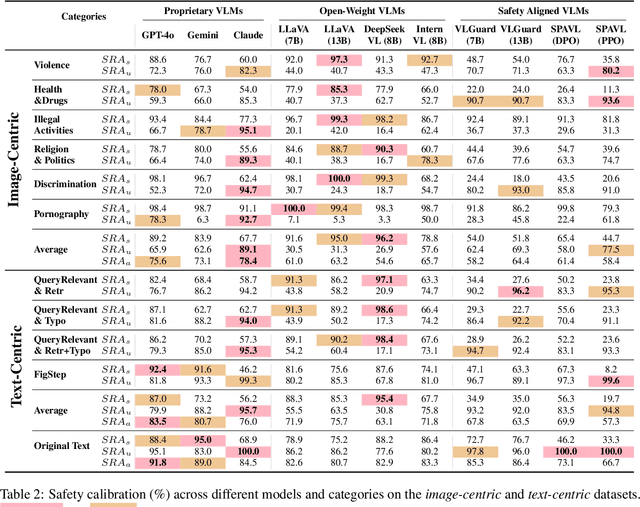
Abstract:The rapid advancement of vision-language models (VLMs) has brought a lot of attention to their safety alignment. However, existing methods have primarily focused on model undersafety, where the model responds to hazardous queries, while neglecting oversafety, where the model refuses to answer safe queries. In this paper, we introduce the concept of $\textit{safety calibration}$, which systematically addresses both undersafety and oversafety. Specifically, we present $\textbf{VSCBench}$, a novel dataset of 3,600 image-text pairs that are visually or textually similar but differ in terms of safety, which is designed to evaluate safety calibration across image-centric and text-centric scenarios. Based on our benchmark, we evaluate safety calibration across eleven widely used VLMs. Our extensive experiments revealed major issues with both undersafety and oversafety. We further investigated four approaches to improve the model's safety calibration. We found that even though some methods effectively calibrated the models' safety problems, these methods also lead to the degradation of models' utility. This trade-off underscores the urgent need for advanced calibration methods, and our benchmark provides a valuable tool for evaluating future approaches. Our code and data are available at https://github.com/jiahuigeng/VSCBench.git.
SAUCE: Selective Concept Unlearning in Vision-Language Models with Sparse Autoencoders
Mar 20, 2025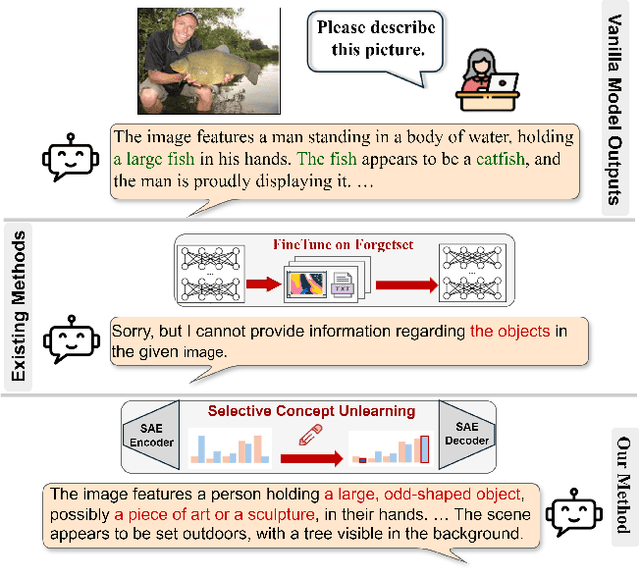
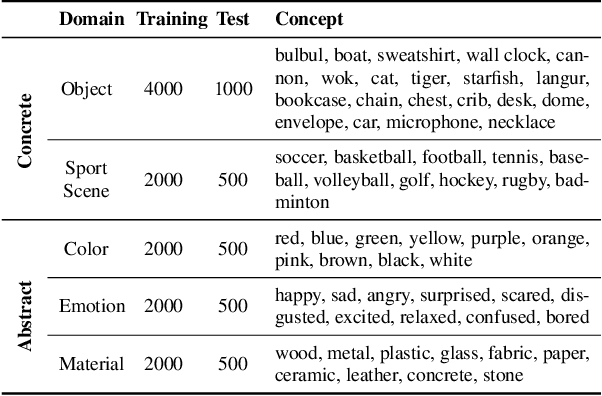

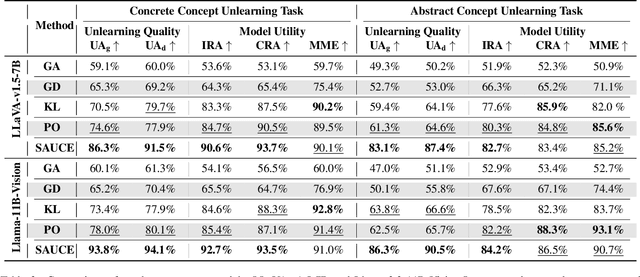
Abstract:Unlearning methods for vision-language models (VLMs) have primarily adapted techniques from large language models (LLMs), relying on weight updates that demand extensive annotated forget sets. Moreover, these methods perform unlearning at a coarse granularity, often leading to excessive forgetting and reduced model utility. To address this issue, we introduce SAUCE, a novel method that leverages sparse autoencoders (SAEs) for fine-grained and selective concept unlearning in VLMs. Briefly, SAUCE first trains SAEs to capture high-dimensional, semantically rich sparse features. It then identifies the features most relevant to the target concept for unlearning. During inference, it selectively modifies these features to suppress specific concepts while preserving unrelated information. We evaluate SAUCE on two distinct VLMs, LLaVA-v1.5-7B and LLaMA-3.2-11B-Vision-Instruct, across two types of tasks: concrete concept unlearning (objects and sports scenes) and abstract concept unlearning (emotions, colors, and materials), encompassing a total of 60 concepts. Extensive experiments demonstrate that SAUCE outperforms state-of-the-art methods by 18.04% in unlearning quality while maintaining comparable model utility. Furthermore, we investigate SAUCE's robustness against widely used adversarial attacks, its transferability across models, and its scalability in handling multiple simultaneous unlearning requests. Our findings establish SAUCE as an effective and scalable solution for selective concept unlearning in VLMs.
FilterLLM: Text-To-Distribution LLM for Billion-Scale Cold-Start Recommendation
Feb 24, 2025Abstract:Large Language Model (LLM)-based cold-start recommendation systems continue to face significant computational challenges in billion-scale scenarios, as they follow a "Text-to-Judgment" paradigm. This approach processes user-item content pairs as input and evaluates each pair iteratively. To maintain efficiency, existing methods rely on pre-filtering a small candidate pool of user-item pairs. However, this severely limits the inferential capabilities of LLMs by reducing their scope to only a few hundred pre-filtered candidates. To overcome this limitation, we propose a novel "Text-to-Distribution" paradigm, which predicts an item's interaction probability distribution for the entire user set in a single inference. Specifically, we present FilterLLM, a framework that extends the next-word prediction capabilities of LLMs to billion-scale filtering tasks. FilterLLM first introduces a tailored distribution prediction and cold-start framework. Next, FilterLLM incorporates an efficient user-vocabulary structure to train and store the embeddings of billion-scale users. Finally, we detail the training objectives for both distribution prediction and user-vocabulary construction. The proposed framework has been deployed on the Alibaba platform, where it has been serving cold-start recommendations for two months, processing over one billion cold items. Extensive experiments demonstrate that FilterLLM significantly outperforms state-of-the-art methods in cold-start recommendation tasks, achieving over 30 times higher efficiency. Furthermore, an online A/B test validates its effectiveness in billion-scale recommendation systems.
 Add to Chrome
Add to Chrome Add to Firefox
Add to Firefox Add to Edge
Add to Edge